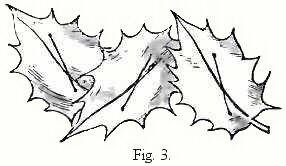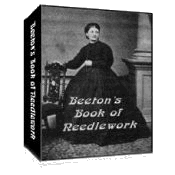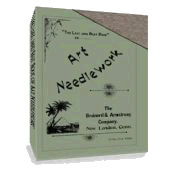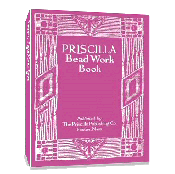Victorian Christmas Decorations for
the Church and Home
Victorian Christmas decorations for the Church and home ranged from almost non-existent to opulent. While home tree decorations usually get the most attention, it is plain to see from the following article, that although not everyone believed in, or wanted to, decorate the Church for the holiday, those that did had no shortage of ideas.
Most of the items in this three part article are designed for the church but some could very well be used in the home as a reminder of why we really celebrate Christmas.
Christmas Decorations
Published in Cassell's household guide: being a complete encyclopaedia of domestic and social economy and forming a guide to every department of practical life (1869)
Some of our readers will probably not share in the desire to adorn places of worship, which actuates a large section of the religious community at Christmas-time; but they may at least regard the subject as interesting and curious, and many of the designs are adapted for the decoration of home, in a manner appropriate to the season, without indicating any particular mode of religious thought, or involving points of doctrine or ceremony respecting which members of various communities might entertain different opinions.
There are many ways of decorating churches and houses for Christmas-time. One very effective and not tedious way is to make a frame the shape desired of laths nailed together, and stretch tightly and evenly over the frame some white calico. With a blue chalk pencil draw an outline of the text on the calico, and then over the letters sew single holly-leaves. Make a border of leaves. Bunches of yellow, and red, and orange-coloured immortelles may be placed at the prominent parts of the letters, or worked into the borders.

Fig. 1 shows one of these frames, with the calico stretched on it and the text worked.
Fig. 2 gives in detail the Sacred Name, showing how frames and leaves may be arranged.
First of all, in making these texts, take the branches of holly and clip off all the leaves with a pair of old scissors, and drop them into a couple or three little baskets, so as to sort the sizes as they are cut off. Waste-paper baskets, or old strawberry' baskets, are useful for the purpose.
Take a No. 6 needle (Morris and Yeomans', Redditch, will be found very good for the purpose), as the passage of thread through the hole is facilitated by the make; use dark green cotton, and sew on leaf by leaf in the manner shown in detail in Fig. 3, below.

The deep slanting shelf left by the thickness of the wall under many church windows can be very effectively decorated in this manner. The frames must be made to fit the windows. A couple of nails at the top of the slanting-place allow the frame to be hitched on them, and will keep it in place. Where the ledge of windows is flat, decorations would be lost. But they may very well be suspended along the galleries, in which case they should have frames of evergreen garlands, which on the window ledges are better dispensed with.
It has a beautiful effect in many churches, to erect an evergreen screen before the communion table. This is particularly appropriate to those built for choral service, and which have a space before the communion of choristers' seats. Most of the old churches were so built, and the seats — choral service not being retained in them — appropriated to members of the congregation. The screen is still suitable in such a case.

Fig. 4, above, represents one of these screens. One side is shown covered with the holly, and the other exhibits the framework.
To make the frame, first construct a square of laths the size of the aperture to be filled, and represented by A, B, C, D, Fig. 4. Then place across the laths, E, F and G, H. Next make the trellis-work at the lower part. Place the upright laths to form the arches, at I. Next cross them with pieces of crinoline cane, or pliant boughs, in the way shown at J.
The triple circles at the top, which are emblematic of the Trinity, are garlands made on pliant boughs, such as lilac-bushes afford, tacked at the bows marked K K K, and tied together in centre with string. A bunch of immortelles is placed in the centre of each. Festoon a garland from G to H, filling the spaces between the triple circles. If a wire is run into the garland it will stiffen it enough to enable it to be moulded to form. A cap-wire is useful, because the leaves can be sewn to it. But the garlands may be made on rope with a strong wire tied in with it. The upright laths of the arches are covered with green. Then form the garlands for the arches on wire or cane, and place them in a row over the top.
The text is made on calico, stretched on a frame in the manner already described. It is placed in its position last of all, and a garland of leaves then carried round it as a frame. The trellis- work is previously covered with leaves. Fig. 4 indicates how the immortelles may be used. White, yellow, scarlet, and crimson are the colours to select. Do not mix them, but place bunches of each colour regularly arranged. If any members of the congregation sit behind the screen, it is essential that the back should also be covered with leaves.
For more, continue to:
Victorian Christmas Decorations for the Church and Home Part 2.
Victorian Christmas Decorations for the Church and Home Part 3.
And for decorations specifically for the home, see Victorian Household Christmas Decorations.
Return to top of Victorian Christmas Decorations page.
Return to Victorian Christmas page.
The Last and Best Book of Art Needlework
Over 100 pages of authentic Victorian instructions and patterns from 1895!
FREE
Beeton's Book Of Needlework

433 pages!
Sign up for VEAC! Everything you wanted to know about Victorian embroidery, needlework, crafts and more!
Priscilla Bead Work Book
Make Beautiful Victorian Beaded Purses, Jewelry & Accessories - Starting
TODAY!



